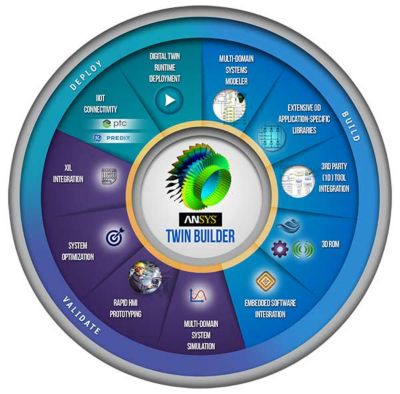-
-
Kostenlose Software für Studierende
Ansys unterstützt die nächste Generation von Ingenieur*innen
Studenten erhalten kostenlosen Zugang zu erstklassiger Simulationssoftware.
-
Verbinden Sie sich jetzt mit Ansys!
Gestalten Sie Ihre Zukunft
Stellen Sie eine Verbindung mit Ansys her, um zu erfahren, wie Simulation Ihren nächsten Durchbruch vorantreiben kann.
Länder und Regionen
Kostenlose Demoversionen
Produkte & Dienstleistungen
Lernportal
Über das Unternehmen
Back
Produkte & Dienstleistungen
Back
Lernportal
Ansys unterstützt die nächste Generation von Ingenieur*innen
Studenten erhalten kostenlosen Zugang zu erstklassiger Simulationssoftware.
Back
Über das Unternehmen
Gestalten Sie Ihre Zukunft
Stellen Sie eine Verbindung mit Ansys her, um zu erfahren, wie Simulation Ihren nächsten Durchbruch vorantreiben kann.
Kostenlose Demoversionen
ANSYS BLOG
May 21, 2018
Digital Twins: Realizing the Predictive Maintenance Vision
One of the newest and most exciting frontiers in simulation is the concept of digital twins. According to recently released survey results reported by Gartner, 48 percent of companies already realizing the benefits of the internet of things (IoT) are using or plan to use digital twins by the end of this year. And, at least 50 percent of manufacturing companies with annual revenues of more than $5 billion plan to start at least one digital twin initiative by 2020.
But first, what is a digital twin? The term is wildly used across industries with various meanings. Here’s how I define a digital twin: It is a simulated, virtual model of an actual working product in the field, informed by sensors mounted on the physical product that gather and send back real-time, real-world operating data. By studying the digital twin under actual working conditions, companies, for the first time, can analyze the product in action, over time, in its actual operating environment. This feedback enables the product development team to close the loop on its initial simulations by revealing strengths and weaknesses of the design in the field. Engineers can make more informed choices for future designs and improve the accuracy of their simulations.
Even more important, digital twins enable true predictive maintenance for the first time. Instead of overservicing or overmaintaining products to avoid costly downtime, repairs or replacement, companies can act “just in time” to address any product performance issues predicted by the digital twin. They can accurately visualize exactly when and where maintenance is needed, instead of making blind guesses and safe bets. Costly unplanned downtime is replaced by less expensive maintenance during scheduled shutdowns.
The time and cost savings are substantial. Enabled by the rise of smart connected product technology — which allows durable, competitively priced sensors to be mounted on working machines and devices — the digital twin is an idea whose time has clearly arrived.
A New Ansys Tool to Get Started with Digital Twins
At this point, you are probably wondering how your company can begin using digital twins to optimize your operations. Until now, this has been major challenge because of the specialized expertise and cross-functional partnerships required. What’s needed is a straightforward, best-in-class solution for creating, validating and deploying digital twins. I’m excited to tell you that Ansys has created such a solution with the recently released Ansys Twin Builder.
What is Twin Builder, and how can it help your organization build, deploy and connect digital twins?
Twin Builder is a predictive maintenance software product that makes it quick and easy for you to develop your first digital twin. It combines the power of a multidomain systems modeler with extensive 0D application-specific libraries, 3D physics solvers and reduced-order modeling capabilities. When combined with Ansys embedded software development tools, you can reuse existing components and quickly create a systems model — a digital twin — of your product.
To validate your system, Twin Builder combines multidomain systems simulation capabilities with rapid human-machine interface (HMI) prototyping, systems optimization and XiL validation tools, ensuring that your system design will perform as expected.
To connect your digital twin to test data or real-time data, Twin Builder easily integrates with IoT platforms and contains runtime deployment options. Once connected, your digital twin can use the current state of your product to simulate future states, enabling you to predict when problems might occur. You can use these predictions to schedule maintenance on your physical product. Twin Builder is the only product that offers a packaged approach for your digital twin strategy.
Building Your Digital Twin
You can reduce the engineering time required to build an accurate physics-based digital twin by a factor of two through model reuse and easy composition. To achieve this goal, Twin Builder provides:
- Support for multiple modeling domains and languages.
- Extensive 0D application-specific libraries.
- Third-party tool (including 1D) integration.
- 3D reduced-order model creation and integration.
- Embedded software integration.
Validating Your Twin
By validating that your digital twin is an accurate representation of your product, you can optimize product performance by 25 percent by leveraging:
- Multidomain simulation with integrated post-processing.
- Rapid HMI prototyping.
- Systems optimization.
- XiL integration.
Deploying Your Twin
A digital twin can improve your operations while reducing maintenance costs 10 to 20 percent by:
- Quickly connecting to supported IoT platforms.
- Exporting and deploying generated models.
Learn More
Take a look at our new white paper, Digital Twins: Making the Vision Achievable or learn more about Ansys Twin Builder capabilities on our website.

